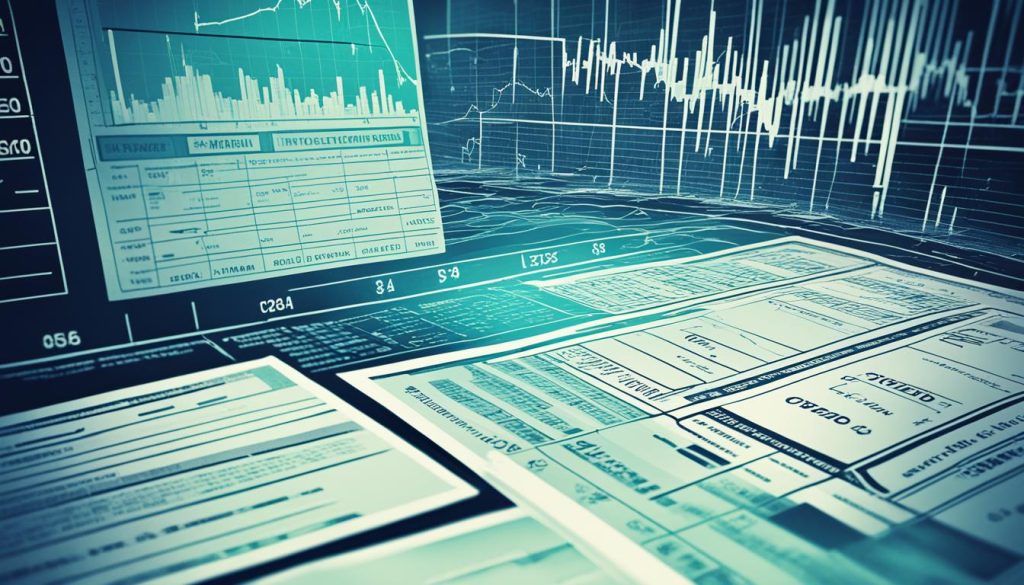Creating a strong credit risk management plan is key for banks and lenders. It helps them reduce risks and increase profits and productivity. By learning the best ways to manage credit risk, you can make a solid risk assessment plan1. 76% of traditional banks worry about new fintech, but a good credit risk management plan boosts their security. It also helps borrowers get loans they can afford, improving their credit1.
Managing credit risk means checking how likely a borrower will pay back the loan. This looks at their finances, income, and past borrowing and payments1. The “Five Cs of Credit” – character, capacity, capital, collateral, and conditions – are important in this check1. Charging higher interest to borrowers with moderate risk is another key part of managing credit risk well1.
Technology like data analytics and machine learning is key in better predicting credit risk by finding patterns in big data2. Automated tools make checking risks faster and less prone to mistakes2. Also, spreading risks across different areas is important to avoid too much risk in one place2.
Key Takeaways
- Crafting an effective credit risk management strategy is essential for banks and lenders to minimize risks while maximizing profits and productivity.
- The credit risk management process involves evaluating a borrower’s creditworthiness based on the “Five Cs of Credit” – character, capacity, capital, collateral, and conditions.
- Technology, including data analytics and machine learning, plays a vital role in improving credit risk prediction and streamlining the assessment process.
- Diversification strategies are crucial in mitigating concentration risk by spreading exposure across various entities or sectors.
- Ongoing monitoring and real-time data updates are essential for efficient credit risk management.
- Credit risk manuals
- https://criminalinjurylaw.com/settlement-scam-stories-how-lawyers-keep-your-payouts-for-themselves-8/
Understanding the Credit Risk Management Process
The credit risk management process is key in banking and lending. It checks how likely a borrower can pay back a loan3. Lenders look at the borrower’s finances, income, and past loans to figure out the risk3. But, this method often misses other factors that could change the loan’s risk level.
What is the Credit Risk Management Process?
This process aims to understand the risks of lending money3. Good credit risk systems help banks make smart choices and stay safe3. These ratings help decide if to approve a loan, set interest rates, and manage risks3.
Why is Credit Risk Management Important?
Risks in banking can be lowered3. Banks work hard to fight fraud and keep customer data safe4. They also aim to avoid lending to unreliable borrowers3. Missing payments or defaulting on loans can cause banks to lose money, even if they have collateral3. That’s why it’s key to check a borrower’s credit risk and financial situation before lending4.
Good credit risk management helps avoid defaults and keeps cash flow steady4. Using technology makes managing credit risks better, allowing for quick checks and better risk management4.
The pandemic made more people need quick loans, changing the lending world5. Using AI can make checking creditworthiness faster and more accurate5. AI and ML improve risk prediction by 20%, showing how technology is changing risk management5.
| Key Aspects of Credit Risk Management | Description |
|---|---|
| Creditworthiness Evaluation | Looking at a borrower’s finances, payment history, and risk factors to see if they can repay the loan. |
| Loan Evaluation | Reviewing the loan’s details, like its purpose, amount, collateral, and repayment plan, to understand the risk. |
| Borrower Reliability | Checking the borrower’s trustworthiness, ability to pay, and other factors to see if they’re reliable. |
| Credit Risk Mitigation | Using strategies to lower the chance of loan defaults, like setting credit limits and requiring collateral. |
| Fraud Prevention | Using strong security and fraud detection to protect against financial losses from fraud. |
In summary, managing credit risk is vital for lenders3. It helps them understand and reduce the risks of lending to borrowers3. By looking closely at creditworthiness and other factors, lenders can make smart choices and protect their money4. New technologies like AI and ML are making credit risk management even better5.
Best Practices for Managing Credit Risks
Managing credit risk is key to staying financially stable and profitable. It’s vital to use effective credit risk management techniques to keep a healthy credit portfolio6. The first step is to understand the borrower by using the “Five Cs of Credit”6.
Financial institutions can reduce risk and increase profit by constantly checking data sources6. They should also validate scorecard models often6 and keep an eye on them6. Using dynamic data6 and AI and machine learning6 helps too. Plus, being ready for financial crimes6 is important.
Having accurate and easy-to-get data is key for good credit risk checks6. New lenders and fintech companies bring new challenges to managing credit risk6. Economic ups and downs can also affect how creditworthy borrowers are6. Real-time checks help spot and fix credit risks early6.
Creating and sticking to a solid credit policy is crucial for businesses to avoid financial risks and deal with defaulting customers6. By using these best practices, financial institutions can improve their credit risk management. This helps them handle the changing credit scene better6.
| Credit Risk Management Technique | Description |
|---|---|
| Five Cs of Credit | A comprehensive framework for evaluating a borrower’s creditworthiness, including Character, Capacity, Capital, Collateral, and Conditions. |
| Scorecard Model Validation | Regularly validating the accuracy and reliability of credit risk scoring models to ensure they effectively assess borrower risk. |
| Dynamic Data Monitoring | Continuously monitoring and incorporating real-time data sources to identify changes in borrower creditworthiness and adjust credit decisions accordingly. |
| AI and Machine Learning | Leveraging advanced analytics and predictive modeling techniques to enhance credit risk assessment and fraud prevention efforts. |
By following these best practices, financial institutions can improve their credit risk management. This helps them handle the changing credit scene better6.
“Effective credit risk management is essential for maintaining financial stability and profitability in today’s competitive lending environment.”
Effective Methods for Managing Credit Risks
Advantages & Disadvantages of Credit Risk Management
Lenders use many ways to handle credit risks. One method is risk-based pricing, where those seen as moderate risk pay more interest7. They also ask for periodic MIS reporting to check on borrowers’ finances and repayment ability7.
A strong credit risk management system has many benefits. It includes comprehensive credit analysis7, spreading out credit risks7, and keeping an eye on credit status7. But, it also has challenges. These are inefficient data management8, not enough infrastructure8, and poor reporting and visualization8.
Also, stress testing shows how bad economic times could affect the credit portfolio7. Having a robust credit risk management framework is key. It needs clear policies, steps, and controls for good risk handling7.

“Effective credit risk management is a critical component of a lender’s overall risk management strategy, helping to minimize losses and protect the institution’s financial health.”
| Advantages | Disadvantages |
|---|---|
| Comprehensive credit analysis | Inefficient data management |
| Diversification of credit portfolio | Limited infrastructure |
| Regular credit monitoring | Poor reporting and visualization |
| Stress testing | |
| Robust credit risk management framework |
How Do Banks Manage credit risk manuals
Managing credit risk is key for banks to stay stable and profitable. At the core, credit risk modeling uses data to predict if borrowers will default and how it will affect the bank10. Banks use advanced analytics and big data to improve their credit risk checks. This helps them decide on loans and interest rates better10.
The Federal Reserve has given guidance on managing credit risk. SR 21-19 reminds banks how to handle counterparty credit risk safely. SR 20-14 / CA 20-8 talks about lending small-dollar loans responsibly, stressing the need for good risk management10. SR 19-8 also outlines what banks should do with the Current Expected Credit Losses (CECL) method, a key part of managing credit risk10.
Banks use their own credit risk ratings to check how likely borrowers are to pay back. The Bank Holding Company Supervision Manual talks about the importance of good credit checks and ratings in banks10. The Commercial Bank Examination Manual gives advice on handling credit risks in lending, like farm loans and real estate10.
To handle credit risk well, banks need to watch out for concentration risks, like lending too much to one borrower or industry11. They must keep an eye on credit, interest rate, liquidity, and operational risks to keep their banks safe and sound11.
By using advanced analytics, following rules, and having strong internal risk management, banks can handle credit risk well. This helps them keep a healthy loan portfolio12. This approach is key for banks to support their customers and the economy12.

Technology in Credit Risk Analysis
Technology has changed how we look at credit risk. Now, with data analytics and machine learning, making credit decisions is faster and more precise13. These tools help big companies make better choices and lower their risks13.
Types of Credit Risk
There are several types of credit risk that companies face:
- Default risk – the chance a borrower won’t pay back what they owe
- Credit spread risk – the risk of interest rates changing between different bonds
- Concentration risk – when a company’s money is tied up in one place, like one borrower or industry
- Downgrade risk – the risk of a borrower’s credit score going down
Understanding these risks helps companies protect their money13.
Data analytics and machine learning are key in credit risk analysis13. AI can look at lots of data fast, helping companies make quick, smart choices13. These tools also give more accurate risk scores, lowering the chance of default and boosting performance13.
AI in credit risk management makes things faster and more precise, cutting down on risks and making decisions better for big companies13. It automates scoring and approval, making it easier for credit teams13. Real-time monitoring helps teams keep an eye on risks and get alerts about changes in credit scores13.
Real examples show AI’s benefits. Companies like Mosaic and Chevron Phillips Chemical have seen better decisions, less risk, and more cash flow13.
Automated risk assessments cut down on mistakes, almost eliminating errors like wrong numbers or misreading data14. This automation can save money and time in banking, reducing losses by 10% and cutting costs by half14.
Banks using digital tools have seen big improvements, like better predicting credit risks with machine learning14. Going digital has led to more client interactions and faster decisions, like in underwriting14.
Machine learning in credit risk has made predictions 70 to 90% more accurate, spotting late payments months ahead14. In mortgages, digital tools have made appraisals happen in real-time, saving money and time during important decisions14.
The future of credit risk management is all about technology working together smoothly. Banks that use digital tools now will likely lead the way in the next five years14.
“By leveraging advanced algorithms and automated risk assessment tools, organizations can now make faster, more accurate, and more consistent credit decisions.”
Creating an Enterprise Risk Management Diagram
Making a good enterprise risk management (ERM) diagram is key for financial groups to handle complex risks. Wondershare EdrawMax offers a simple way to turn risk data into clear visuals. This helps with better communication and making smart choices15. It’s easy to use and has lots of templates, helping teams spot risks, show how they connect, and plan how to fix them15.
At the core of an ERM diagram is risk visualization. It turns hard-to-understand risk data into something easy to see. This helps financial groups see how different risks are linked and plan a full risk strategy to tackle them15. This way, risk mitigation gets better, and teams work better together. Everyone knows what risks are and how to deal with them15.
EdrawMax lets financial groups make ERM diagrams that fit their needs. It has lots of templates, like risk registers and SWOT analyses, to help make detailed and eye-catching ERM visuals15. With this tool, teams can share complex risk info easily, make risk management smoother, and make smarter choices15.
In today’s changing financial risk world, being able to see and manage risks across the whole company is key. Wondershare EdrawMax helps financial groups improve their enterprise risk management skills. It turns complex data into clear plans for success15.
Conclusion
Managing credit risk is key to your organization’s stability and growth. Using new technologies like data analytics and automated tools makes your credit risk analysis better and faster16. Tools like EdrawMax’s ERM diagrams help you share and understand your risk management plans better, making it easier to make smart financial choices.
Improving your credit risk management means following the best practices and rules. A strong focus on good underwriting, diversification, and managing risks ahead of time helps your organization succeed over the long term16. With the right mix of technology, knowledge, and planning, you can handle credit risks well and make smart financial moves.
Handling credit risk well means always being alert, ready to change, and focused on getting better. By using the tools and strategies we talked about, you can help your organization do well in the changing financial world17. This helps you avoid risks and find new chances for growth and success.
FAQ
What is the credit risk management process?
The credit risk management process looks at a borrower’s financial health, income, and past loans. It helps figure out how likely they are to pay back a loan.
Why is credit risk management important?
It’s key for banks to keep risks low and make more money. It keeps them safe from bad loans, fraud, and data breaches. This protects their customers’ financial info too.
What are some best practices for managing credit risks?
Good practices include checking data often, making sure scorecards are up to date, and watching models closely. Using AI and machine learning helps too. Also, being ready for financial crimes is important.
What are the advantages and disadvantages of credit risk management?
The good parts include deep analysis and talking with borrowers early. But, managing data well can be hard. Also, some places lack the right tools and clear reports.
How do banks manage credit risk?
Banks use credit risk models to guess if a borrower might not pay back and how big the loss could be. They use big data and advanced analytics to check if someone is good for a loan. Then, they set interest rates based on this.
What is the role of technology in credit risk analysis?
Technology is a big help in credit risk analysis. It makes decisions better and faster. Tools and software automate risk checks, making things safer.
What are the key types of credit risk?
The main credit risks are default risk, credit spread risk, concentration risk, and downgrade risk.
How can an Enterprise Risk Management (ERM) diagram help with credit risk management?
ERM diagrams, made with tools like EdrawMax, help show and share credit risk plans. They make it easier to talk about risks and make smart choices.
Source Links
- Credit Risk Management Process, Best Practices & Techniques In Banks
- Mastering Credit Risk Analysis and Management: A Concise Handbook.
- Rating Credit Risk
- 6 Key Credit Risk Mitigation Strategies
- The six elements for a successful credit risk management | ACTICO Blog
- Credit Risk Management: Challenges and Best Practices
- Credit Risk Management: Best Practices And Strategies For Managing Credit Risk
- A Guide To Managing Credit Risks For A Strong Bottom Line
- Interagency Guidance on Credit Risk Review Systems
- The Fed – Supervisory Policy and Guidance Topics
- Concentrations of Credit, Comptroller’s Handbook
- Risk Management in Banking: Types + Best Practices for Mitigation | Risk Management and Financial Institutions – Blog | Unit21
- How AI is Transforming Credit Risk Management?
- Transforming Credit Risk Assessment: The Digital Revolution in Lending
- Enterprise Risk Management: Strategies and Benefits
- Credit Risk Management
- Credit Risk Management Guide for Banks and Financial Institution

